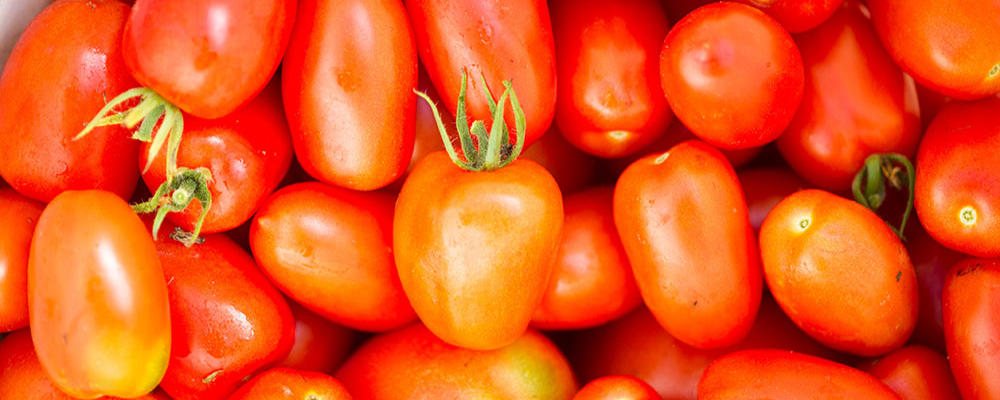
Best Types of Tomatoes For Canning
— By Kate McCarty, Food Systems Professional, University of Maine Cooperative Extension and Master Food Preserver Volunteers Abbie Perry and Tyra Hatcher Mitchell
Tomatoes are one of the most popular home canned products—canned tomatoes are versatile in cooking, relatively easy (if not labor-intensive), and delicious. Whether you are canning tomatoes whole, in pieces, as juice or sauce, the variety of tomato doesn’t matter from a safety perspective (all home canned tomatoes do need to have acid added to be safe to can—read more about acidification in the section below).
Factors to consider when selecting tomatoes for canning include flavor, moisture content, and the number of seeds. If you are growing tomatoes, you’ll want to know if your plant is determinant, meaning its fruit ripens all at once, or indeterminate, where fruit ripens over the course of several weeks.
Best Types of Paste Tomatoes for Canning
Many people prefer paste tomatoes for making thicker products like sauce, salsa, ketchup, and paste. These tomato varieties have less water in the flesh, which means the salsa or sauce thickens faster and takes less time to reduce to a desired consistency. The skins on paste tomatoes are also thicker, which makes them easier to peel.
Plum tomatoes like Roma, Amish paste, or San Marzano are both good choices. San Marzano has only two seed chambers, and both San Marzano and Amish Paste are less acidic than Romas which makes them a sweeter choice.
If you are looking for a non-red paste variety, try Italian Gold which is a compact pear shaped tomato that contains higher pectin making it great for canning or freezing. Other popular paste tomato varieties for canning are Hogheart, Granadero, Opalka, Oxheart, and Roman Candle.
Best Types of Slicing Tomatoes for Canning
Slicing tomatoes is better in tomato juice or canned whole in water or juice. These varieties have more water in the flesh and more seeds. You can use a variety of plums, beefsteaks, brandywine, and Campari tomatoes when making tomato juice. Campari is one of the juiciest tomatoes with a sweet, high sugar content but a low level of acidity. They also have a rich, deep color.
Another aptly-named choice is Saucy which is good for juice or salsa because the fruits contain a good amount of juice. Dense tomatoes like plums are a good choice for salsa. Consider a meaty slicer like Brandywine or German Johnson which are larger and easy to grow. Iron Lady is a dependable, tasty determinate variety that is a good option for a slicer. Other favorites that grow well in Maine include Estiva, Luci, and Moskovitch.
Any variety of slicing tomato can be used in any home canned tomato product, but the cooking time will be longer for thicker products like sauce, paste, and ketchup. Whenever possible, seeds should be removed using a food mill, since seeds can add an unwanted bitterness to your sauce.
We have not had good luck making sauce exclusively from cherry tomatoes, since they don’t have a lot of flesh compared to the number of seeds and amount of skin. But they freeze well and can be roasted in a hot oven prior to freezing to add even more flavor.
Add Acid to All Canned Tomatoes
All tomatoes, regardless of variety or method of canning, need to be acidified for safety. This means adding bottled lemon juice, citric acid, or vinegar to your home canned tomatoes, sauce, juice, or paste.
To acidify your tomatoes, add 1 tablespoon of bottled lemon juice per pint and 2 tablespoons per quart or 1/4 teaspoon of citric acid per pint and 1/2 teaspoon of citric acid per quart.
Use bottled lemon juice instead of fresh lemon juice to ensure a consistent acidity and add the lemon juice directly to the jar before you add the tomatoes. Tomatoes can also be acidified using vinegar, but this may impact the flavor of your product.
These recommendations make sure your tomatoes are safe for home canning so you can enjoy the results of your hard work worry-free!
Resources
- Let’s Preserve: Tomatoes
- Canning Salsa Safely (University of Wisconsin)
- How Do I Can Salsa? (National Center for Home Food Preservation)
- Canning & Freezing Quick Guide: Freezing Vegetables
- How to Freeze Tomatoes Video
- Freezing Raw Tomatoes With and Without Their Skins (University of Nebraska PDF)
